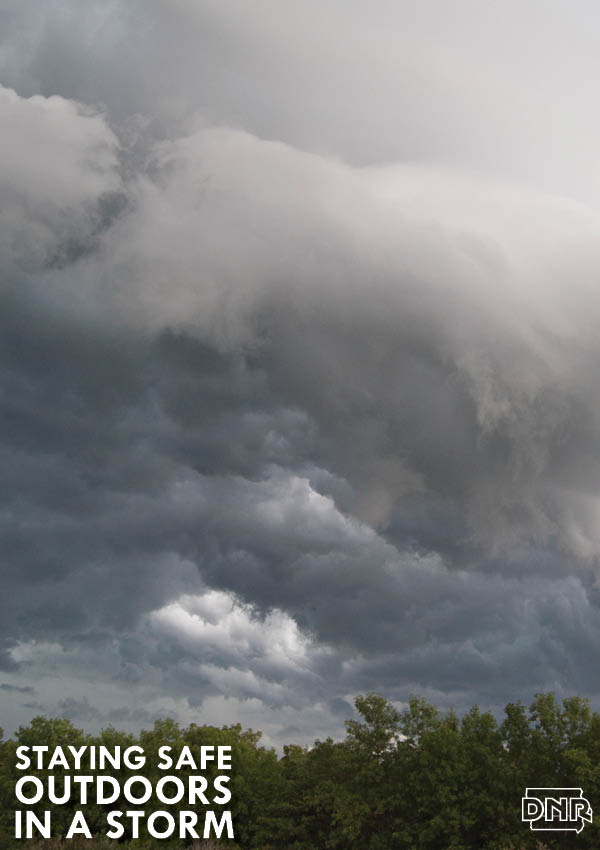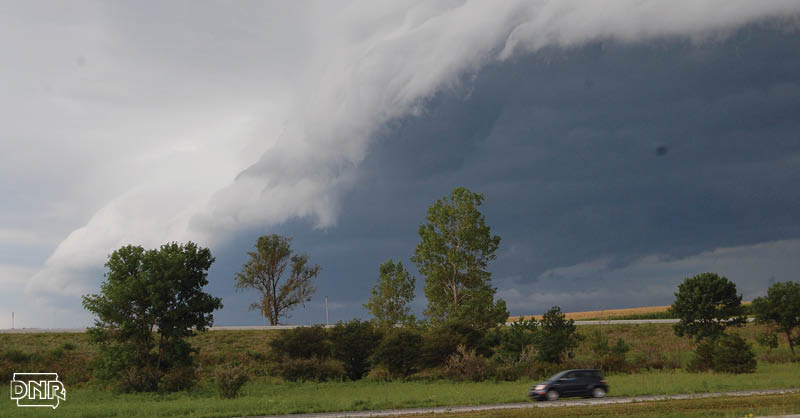 It’s one thing to be caught half a block from the house in a blizzard or thunderstorm. But what do you do if a storm comes up suddenly when you are camping, hiking or boating?
It’s one thing to be caught half a block from the house in a blizzard or thunderstorm. But what do you do if a storm comes up suddenly when you are camping, hiking or boating?
1. Stay on Top of the Weather.
Know what to expect and check the forecast before you leave. Listen to local news. Take a weather radio with you or catch weather alerts from the National Weather Service at www.weather.gov. Look for up-to-date forecasts and maps. Or, sign up for Alert Iowa, a free statewide messaging system available in 79 out of 99 counties. Sign up by county at www.homelandsecurity.iowa.gov/about_HSEMD/alert_iowa.html.
2. Stay Low.
On a hiking trail, on a lake or in a campgrounds, the best protection from tornadoes and lightning is to stay as low as you can. Stay away from ridge tops and avoid standing under trees in a thunderstorm. When golfing, leave your clubs behind. In a boat, get to shore. For tornadoes, if you’re driving, get out of the car and hit the ditch, but watch for flash flooding. Lie flat and cover your head.
3. Take Shelter.
When hiking, camping, hunting or just outdoors, staying safe is your responsibility. Check park flyers, information kiosks and restrooms for storm policies and information. While many state and local parks do not have a storm shelter, they may have information about the closest designated shelter. Some parks have sirens or on-site park rangers who will alert campers, but some do not. Your best protection is to look for information when you arrive and be aware of the weather. When there’s no shelter available, stay low and avoid trees in a tornado or thunderstorm (see Tip 2).
In cold weather, if you can’t find a safe haven, build a rudimentary shelter to keep out wind and snow. Weave brush, bark and long grasses into fallen tree branches to make a lean-to. A waterproof tarp is even better. Cover the ground with dry leaves, fir boughs and cattail fluff to provide insulation. Once you have shelter, build a fire on the leeward side.
4. Dress Appropriately and Stay Hydrated.
Hypothermia occurs when your body loses heat faster than it can make it. Staying dry is critical. When you’re wet, even slight winds or cool temperatures (30 to 50 degrees) can cause hypothermia. Cold weather hiking calls for a hat, gloves, neck protection and extra socks. Synthetics and wool stay warm, even when wet. Avoid overexertion, dress in many light-weight layers—waterproof and windproof—and stay as dry as possible. Get help immediately for symptoms of hypothermia: slurred speech, loss of coordination, confusion, irrational behavior or continued shivering.
Hyperthermia happens most often in hot, humid weather. Stay hydrated and take breaks to help prevent overheating. Likewise, wearing a hat, sunscreen and loose, light-colored clothing that breathes help stave off heat exhaustion. Watch for signs of heat stroke: cool skin with goose bumps, heavy sweating, fatigue, thirst, dizziness, faintness, headache, low blood pressure upon standing and muscle cramps. Seek help immediately if body temperature reaches 104° or higher.
Year round, be sure to wear blaze orange or other bright-colored clothing, especially on public hunting areas. Camouflaged hikers are hard to find.
5. Leave Your Plans.
Tell someone exactly where you are going and when you expect to return. Carry your emergency contact information. Be prepared to rescue yourself. Don’t assume you will be rescued, especially if hiking or camping in remote areas.
6. Turn Back. Don’t Drown.
Watch for flash flooding. Whether on foot or in a car, it doesn’t take much current to wash you off your path. And there’s no telling what’s under the water. When confronted with high waters, be prepared to turn back, look for another route or wait until flows go down. Don’t take chances.
7. Pack a Kit.
Along with your binoculars, snow shoes, fishing pole or other outdoor gear, be sure to pack plenty of liquids and some high energy food when heading out to the wilds. Even if the wilds is the state park fishing jetty, it pays to have the following essentials along:
• a sharp pocket knife
• fire-making essentials and the knowledge to use them: waterproof matches, flint and steel, or a lighter to start the fire; and dry tender like dryer fluff or cotton balls, plus something guaranteed to burn like your lip balm, Vaseline or a candle
• space blanket or other waterproof sheet
• a light in case you’re caught out after dark
• large garbage bags (for rain gear, emergency shelter or sleeping bag, or yes, to pick up trash along the trail)
• duct tape to fix everything from your fishing pole to open wounds
• first aid kit
• a loud whistle to call for help (cell phones might not work in remote areas like valleys in Ledges State Park)
Add insect spray, hand warmers and sunscreen to suit the season.
